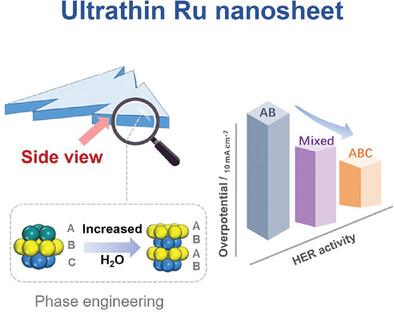超薄 Ru 纳米片的水驱动堆叠结构转变促进高效氢气进化反应
IF 13
2区 材料科学
Q1 CHEMISTRY, MULTIDISCIPLINARY
引用次数: 0
摘要
超薄晶体材料是一类流行的材料,其独特的堆积自由度决定了它们可能表现出迷人的物理和化学特性。然而,要实现对超薄晶体材料堆叠结构的可控合成具有挑战性。在这里,水被用作实现超薄纳米片(NSs)相工程的关键调节因素,从而改变堆叠断层,实现不同的堆叠排列。通过对水的系统调控,制备出了比表面积一致但堆叠方式不同的钌(Ru)纳米片。在此基础上,研究表明氢进化反应(HER)的性能会受到堆叠结构的显著影响。进一步的深入研究发现,Ru NSs 不同的堆叠结构具有有限的侧刻面面积,这将影响氢进化反应中缓慢的沃尔默步骤的能垒。与大多数已报道的 HER 催化剂相比,具有 ABC 堆叠结构的 Ru NSs 的过电位(10 mA cm-2 时为 25 mV)和 Tafel 斜率(29 mV dec-1)明显较低,从而加速了 Volmer 过程,并具有出色的催化活性。这项工作将推动对可控合成方法的理解,并阐明超薄晶体纳米材料的结构-活性关系。本文章由计算机程序翻译,如有差异,请以英文原文为准。

Water-Driven Stacking Structure Transformation of Ultrathin Ru Nanosheets for Efficient Hydrogen Evolution Reaction
Ultrathin crystalline materials are a class of popular materials that can potentially exhibit fascinating physical and chemical properties dictated by their unique stacking freedom. However, it is challenging to achieve the controllable synthesis over their stacking structure for ultrathin crystalline materials. Herein, water is employed as a key regulatory factor to realize phase engineering in ultrathin nanosheets (NSs), thereby altering stacking faults to achieve distinct stacking arrangements. Ruthenium (Ru) NSs with consistent specific surface areas but different stacking manners are fabricated through the systematic regulation of water. Based on this, it is demonstrated that the hydrogen evolution reaction (HER) performance can be significantly influenced by their stacking structures. Further in-depth investigations reveal that the distinct stacking structures of Ru NSs, featuring a limited area of side facets, will influence the energy barrier of sluggish Volmer step in HER. Ru NSs with ABC stacking exhibit an accelerated Volmer process with outstanding catalytic activity, demonstrating a remarkably low overpotential (25 mV at 10 mA cm−2) and Tafel slope (29 mV dec−1) than most of the reported HER catalysts. The work will advance the understanding of controllable synthesis methods and illuminate the structure-activity relationships in ultrathin crystalline nanomaterials.
求助全文
通过发布文献求助,成功后即可免费获取论文全文。
去求助
来源期刊

Small
工程技术-材料科学:综合
CiteScore
17.70
自引率
3.80%
发文量
1830
审稿时长
2.1 months
期刊介绍:
Small serves as an exceptional platform for both experimental and theoretical studies in fundamental and applied interdisciplinary research at the nano- and microscale. The journal offers a compelling mix of peer-reviewed Research Articles, Reviews, Perspectives, and Comments.
With a remarkable 2022 Journal Impact Factor of 13.3 (Journal Citation Reports from Clarivate Analytics, 2023), Small remains among the top multidisciplinary journals, covering a wide range of topics at the interface of materials science, chemistry, physics, engineering, medicine, and biology.
Small's readership includes biochemists, biologists, biomedical scientists, chemists, engineers, information technologists, materials scientists, physicists, and theoreticians alike.
 求助内容:
求助内容: 应助结果提醒方式:
应助结果提醒方式:


